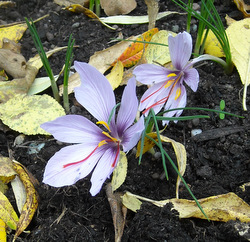How to grow your own saffron
Posted by Fiona Nevile in Plants and Bulbs | 6 comments
Saffron – fragrant, delicate and more expensive than gold can be grown in your own garden. Given the right conditions it is easy to grow. Even though we live just a 25 minute drive from Saffron Walden, where saffron was grown commercially from the 16th to the 18th century, I hadn’t considered growing it myself. Then two years ago I read this post on the Purple Podded Peas blog.
“Hmm.” I thought. “I’d like to try growing some myself.”
And then forgot all about them. The next year Magic Cochin gave me another nudge and I actively began looking for Crocus sativus.
Eventually I spotted saffron crocus corms on the Suttons site – 35 corms for £9.95. The Sutton’s corms are from the Himalayas so can withstand summer heat and freezing winter temperatures. They had to be ordered by June for delivery in early August. They will probably not appear again on the site until next Spring. Sniffing about on the Internet, everyone seems to give the Suttons corms the thumbs up – mine were quite chunky and much bigger than an ordinary crocus bulb.
The corms need to be planted 4” deep and 4” apart in fairly rich well drained soil. Add some sand and grit if necessary – if they sit in wet waterlogged soil they will rot. They do need sun and a south facing border is ideal for them to get the baking that the dormant corms require in the summer. Apparently if you plant them deeper they will produce bigger flowers but the corms will not multiply. They also enjoy a sprinkle of potash and a liquid feed after flowering. If it’s a dry Autumn, water every other day when the leaves begin to appear.
The corms also don’t like to be crowded. So lift and divide up the corms every three years or so. The “free” saffron corms will make this a pleasure in years to come!
Saffron is time consuming to harvest and that is the reason why it is so expensive. But harvesting our own saffron is a joy. There are three long stigmas to each flower. Ideally these should be removed on the day that the flower opens as the saffron deteriorates very quickly – I found this out after I harvested my first strands and you can see that a bird has sampled the leaves and the tip of one of the strands in the photo above. After harvesting fold the strands in a piece of kitchen roll and dry in a warm room until the saffron is brittle, then store in an airtight container in a dry, dark place. It should keep for about a year.
I have recently discovered that saffron had been grown in Amish and Mennonite kitchen gardens for years. This is an inspiring article with further links to some tasty sounding recipes.
Impatient for more, I’m going to buy some corms again next summer. It would be so good to slip some home grown saffron into a Christmas hamper next year. Apart from the saffron, the flowers are very pretty and the leaves stay green all winter which is an added bonus.
N.B. Do not mistake the poisonous Autumn crocus (colchicum) for crocus sativus. The leaves of the saffron crocus appear before the flowers and the beautiful but deadly cochiums flower before the leaves grow.
Leave a reply






Thanks for useful info, i would like to plant crocus can they give the
stames in the first year h0w many stames makes a kilo or to get 1 kilo of stames,how many plants i should grow?
Who would buy the product in bulk and prize value
my regards,
E .Mevlit.
My wife has planted Autumn Crocus along with Saffron Crocus. Should make for a risky paella 🙂
PS Thats a great tip Judy thanks.
I saw these on Sutton’s too and thought about getting them but I wasn’t sure how successful they would be so it’s great to hear you’ve had joy with them. Maybe I’ll get some for next year.
Very timely post as I “harvested” my first 12 stamens yesterday and was not sure how to store them. I put mine in a pot to grow and they seem happy enough.
Fiona, it is very easy to tell crocus from colchicum. All crocus have 3 stames. All colchicum have 6 stamens. Can’t remember which has 3 and which has 6? Crocus is a shorter name / has 3 stamens while colchicum is a longer name / has 6 stamens.